TOYOTA CAMRY HYBRID 2021 Owners Manual (in English)
Manufacturer: TOYOTA, Model Year: 2021, Model line: CAMRY HYBRID, Model: TOYOTA CAMRY HYBRID 2021Pages: 624, PDF Size: 15.98 MB
Page 361 of 624
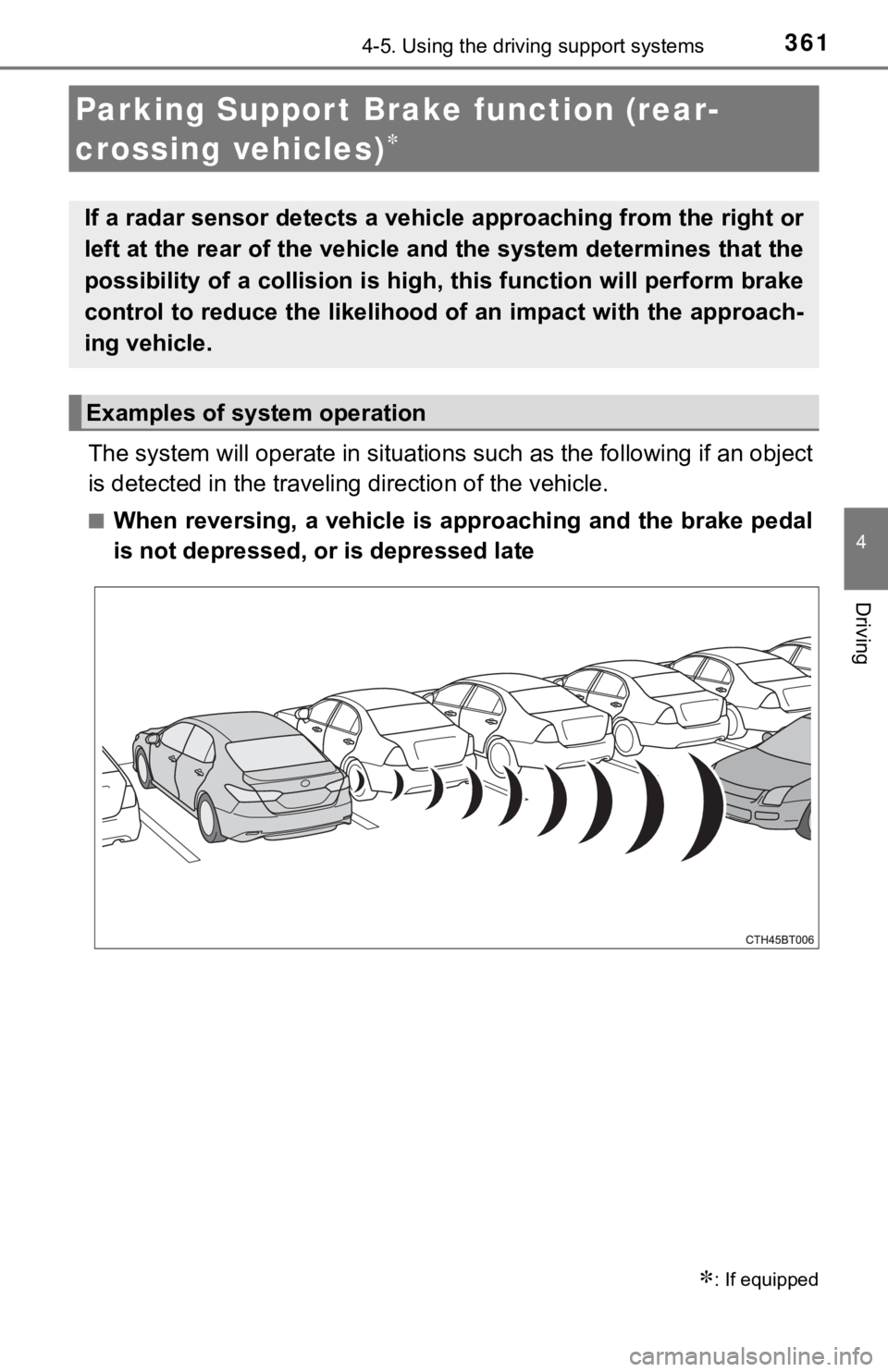
3614-5. Using the driving support systems
4
Driving
The system will operate in situations such as the following if an object
is detected in the traveling direction of the vehicle.
■When reversing, a vehicle is approaching and the brake pedal
is not depressed, or is depressed late
Parking Suppor t Brak e function (rear-
crossing vehicles)
: If equipped
If a radar sensor detects a vehicle approaching from the right or
left at the rear of the vehicle and the system determines that the
possibility of a collision is hi gh, this function will perform brake
control to reduce the likelihood of an impact with the approach -
ing vehicle.
Examples of system operation
Page 362 of 624

3624-5. Using the driving support systems
■The Parking Support Br ake function (rear-crossing vehicles) will operate
when
The function will operate when the PKSB OFF indicator is not illuminated or
flashing ( P. 346, 350) and all of the following conditions are met:
● Hybrid system output restriction control
• The Parking Support Brake is enabled.
• The vehicle speed is approximately 9 mph (15 km/h) or less.
• Vehicles which are approaching from the right or left at the r ear of the
vehicle at a traveling speed of less than approximately 5 mph ( 8 km/h).
• The shift lever is in R.
• The system determines that a stronger than normal brake operat ion is
necessary to avoid a collision with an approaching vehicle.
● Brake control
• Hybrid system output restriction control is operating.
• The system determines that an emergency brake operation is nec essary
to avoid a collision with an approaching vehicle.
■ The Parking Support Brake functi on (rear-crossing vehicles) will stop
operating when
The function will stop operating if any of the following condit ions are met:
● Hybrid system output restriction control
• The Parking Support Brake is disabled.
• The collision becomes avoidable with normal brake operation.
• A vehicle is no longer approaching from the right or left at t he rear of the
vehicle.
● Brake control
• The Parking Support Brake is disabled.
• Approximately 2 seconds elapse after the vehicle is stopped by brake
control.
• The brake pedal is depressed after the vehicle is stopped by b rake con-
trol.
• A vehicle is no longer approaching from the right or left at t he rear of the
vehicle.
■ Detection area of the Parking Su pport Brake function (rear-crossing
vehicles)
The detection area of the Parking Support Brake function (rear- crossing vehi-
cles) differs from the detection area of the RCTA function ( P. 339).
Therefore, even if the RCTA function detects a vehicle and provides an alert,
the Parking Support Brake function (rear-crossing vehicles) may not start
operating.
Page 363 of 624
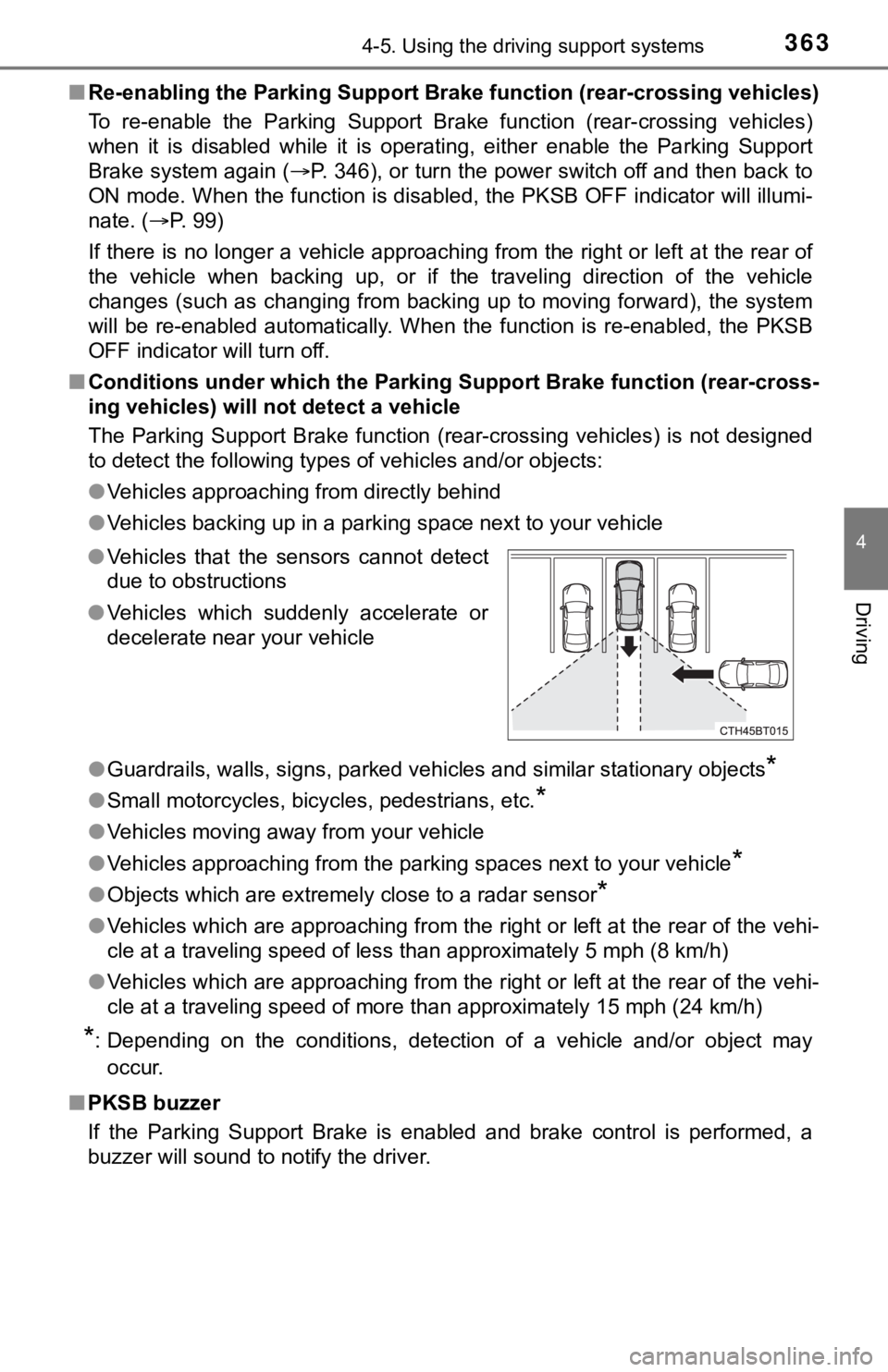
3634-5. Using the driving support systems
4
Driving
■Re-enabling the Parking Suppor t Brake function (rear-crossing v ehicles)
To re-enable the Parking Support Brake function (rear-crossing vehicles)
when it is disabled while it is operating, either enable the Pa rking Support
Brake system again ( P. 346), or turn the power switch off and then back to
ON mode. When the function is disabled, the PKSB OFF indicator will illumi-
nate. ( P. 99)
If there is no longer a vehicle approaching from the right or l eft at the rear of
the vehicle when backing up, or if the traveling direction of the vehicle
changes (such as changing from backing up to moving forward), the system
will be re-enabled automatically. When the function is re-enabl ed, the PKSB
OFF indicator will turn off.
■ Conditions under which the Park ing Support Brake function (rear-cross-
ing vehicles) will not detect a vehicle
The Parking Support Brake function (rear-crossing vehicles) is not designed
to detect the following types of vehicles and/or objects:
● Vehicles approaching from directly behind
● Vehicles backing up in a parking space next to your vehicle
● Guardrails, walls, signs, parked vehicles and similar stationar y objects
*
●Small motorcycles, bicycles, pedestrians, etc.*
●Vehicles moving away from your vehicle
● Vehicles approaching from the parking spaces next to your vehic le
*
●Objects which are extremely close to a radar sensor*
●Vehicles which are approaching from the right or left at the re ar of the vehi-
cle at a traveling speed of less than approximately 5 mph (8 km/h)
● Vehicles which are approaching from the right or left at the re ar of the vehi-
cle at a traveling speed of more than approximately 15 mph (24 km/h)
*: Depending on the conditions, detection of a vehicle and/or obj ect may
occur.
■ PKSB buzzer
If the Parking Support Brake is enabled and brake control is performed, a
buzzer will sound to notify the driver. ●Vehicles that the sensors cannot detect
due to obstructions
● Vehicles which suddenly accelerate or
decelerate near your vehicle
Page 364 of 624
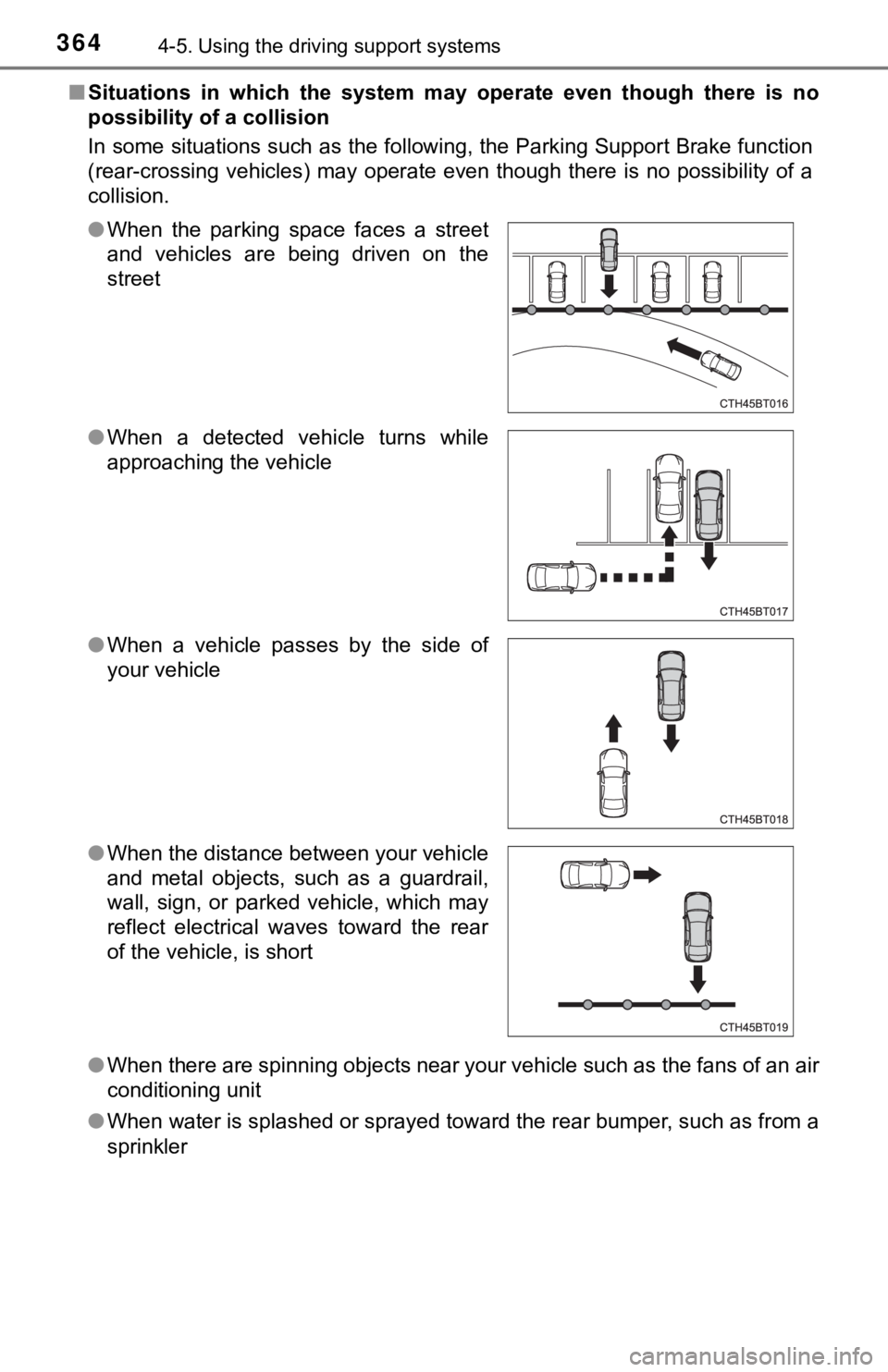
3644-5. Using the driving support systems
■Situations in which the system m ay operate even though there is no
possibility of a collision
In some situations such as the following, the Parking Support B rake function
(rear-crossing vehicles) may operate even though there is no po ssibility of a
collision.
● When there are spinning objects near your vehicle such as the f ans of an air
conditioning unit
● When water is splashed or sprayed toward the rear bumper, such as from a
sprinkler
●
When the parking space faces a street
and vehicles are being driven on the
street
● When a detected vehicle turns while
approaching the vehicle
● When a vehicle passes by the side of
your vehicle
● When the distance between your vehicle
and metal objects, such as a guardrail,
wall, sign, or parked vehicle, which may
reflect electrical waves toward the rear
of the vehicle, is short
Page 365 of 624

3654-5. Using the driving support systems
4
Driving
■Situations in which the Parking Support Brake function (rear-crossing
vehicles) may not operate properly
In some situations such as the following, this function may not operate prop-
erly.
● Objects and vehicles which the radar sensors are not designed t o detect
• Stationary objects
• Vehicles which are moving away from your vehicle
• Pedestrians, motorcycles, bicycles, etc.
*
• Objects which are extremely close to a radar sensor
• Vehicles which are approaching from the right or left at the r ear of the
vehicle at a traveling speed of less than approximately 5 mph ( 8 km/h)
• Vehicles which are approaching from the right or left at the r ear of the
vehicle at a traveling speed of more than approximately 15 mph (24 km/h)
*: Depending on conditions, detection of a vehicle and/or object may occur.
● Situations in which the radar sensors may not be able to detect an object
• When a sensor or the area around a sensor is extremely hot or cold
• If the rear bumper is covered with ice, snow, dirt, etc.
• If heavy rain or water strikes the vehicle
• When the detection area of a radar sensor is obstructed by an adjacent
vehicle
• If the vehicle is significantly tilted
• When equipment that may obstruct a sensor is installed, such a s a towing
eyelet, bumper protector (an additional trim strip, etc.), bicy cle carrier, or
snow plow
• If the suspension has been modified or tires of a size other than specified
are installed
• If the front of the vehicle is raised or lowered due to the ca rried load
• If a sticker or an electronic component, such as a backlit license plate
(especially fluorescent type), fog lights, a fender pole or wir eless antenna
is installed near a radar sensor
• If the orientation of a radar sensor has been changed due to a collision or
other impact or removal and installation
• When multiple vehicles are approaching with only a small gap between each vehicle
• When a vehicle is approaching at high speed
● Situations in which the radar sensor may not detect a vehicle
• When a vehicle approaches from the
right or left at the rear of the vehicle
while you are turning while backing
up
• When turning while backing up
Page 366 of 624
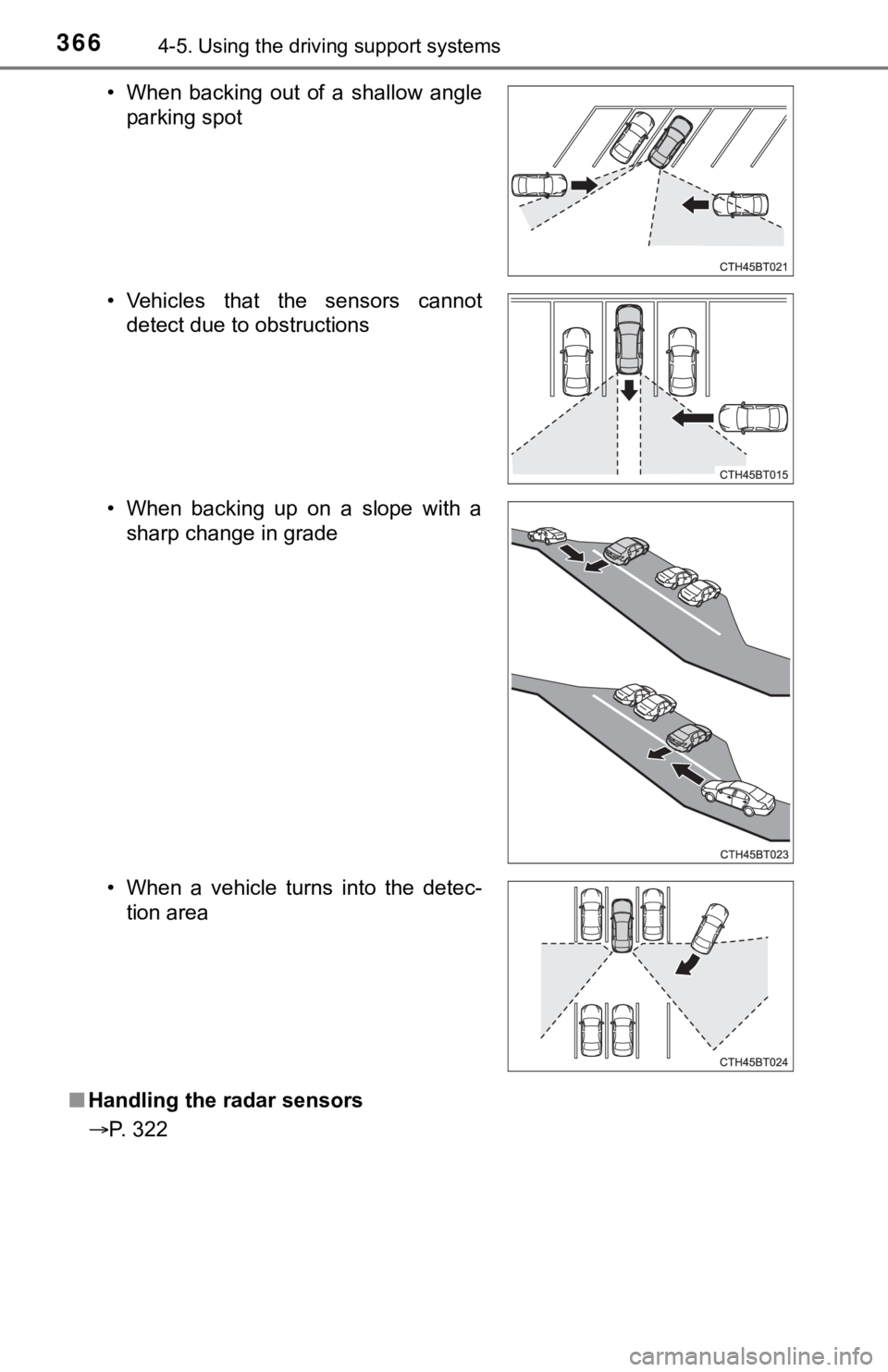
3664-5. Using the driving support systems
■Handling the radar sensors
P. 322• When backing out of a shallow angle
parking spot
• Vehicles that the sensors cannot detect due to obstructions
• When backing up on a slope with a sharp change in grade
• When a vehicle turns into the detec- tion area
Page 367 of 624

3674-5. Using the driving support systems
4
Driving
WARNING
■To ensure the Parking Support Brake function (rear-crossing vehicles)
can operate properly
Observe the following precautions regarding the rear radar sens ors
( P. 322). Failure to do so may cause a sensor to not operate properly, and
may cause an accident.
● Do not modify, disassemble or paint the sensors.
● Do not replace a rear radar sensor with a part other than a genuine part.
● Do not damage the rear radar sensors, and always keep the radar sensors
and their surrounding area on the bumper clean.
● If the area around a rear radar sensor is subjected to an impact, the sys-
tem may not operate properly due to a sensor malfunction. Have the vehi-
cle inspected by your Toyota dealer.
● Observe the rear radar sensor handling precautions. ( P. 322)
Page 368 of 624
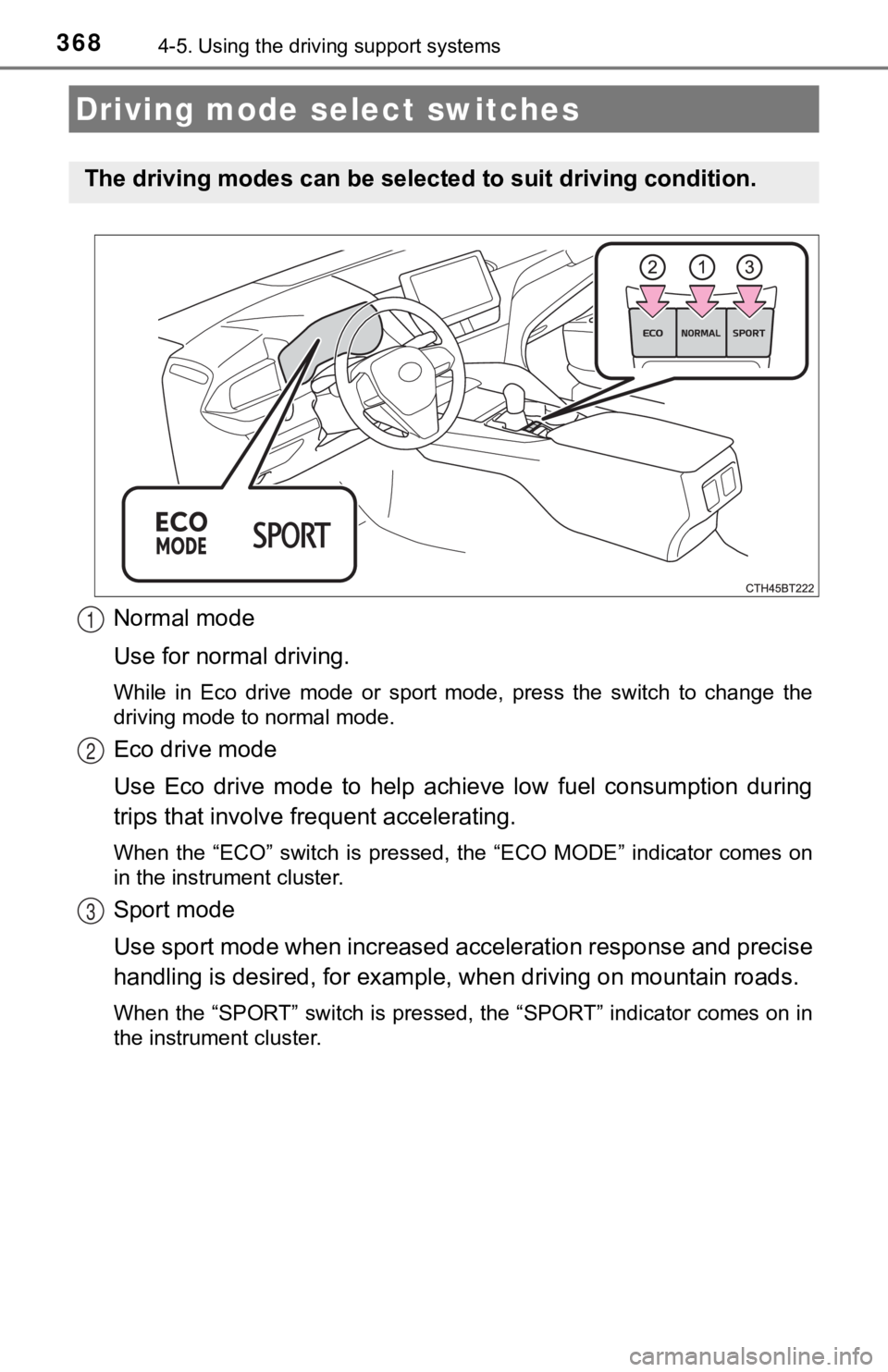
3684-5. Using the driving support systems
Normal mode
Use for normal driving.
While in Eco drive mode or sport mode, press the switch to chan ge the
driving mode to normal mode.
Eco drive mode
Use Eco drive mode to help achieve low fuel consumption during
trips that involve frequent accelerating.
When the “ECO” switch is pressed, the “ECO MODE” indicator comes on
in the instrument cluster.
Sport mode
Use sport mode when increased acceleration response and precise
handling is desired, for exampl e, when driving on mountain road s.
When the “SPORT” switch is pressed, the “SPORT” indicator comes on in
the instrument cluster.
Driving mode select switches
The driving modes can be select ed to suit driving condition.
1
2
3
Page 369 of 624
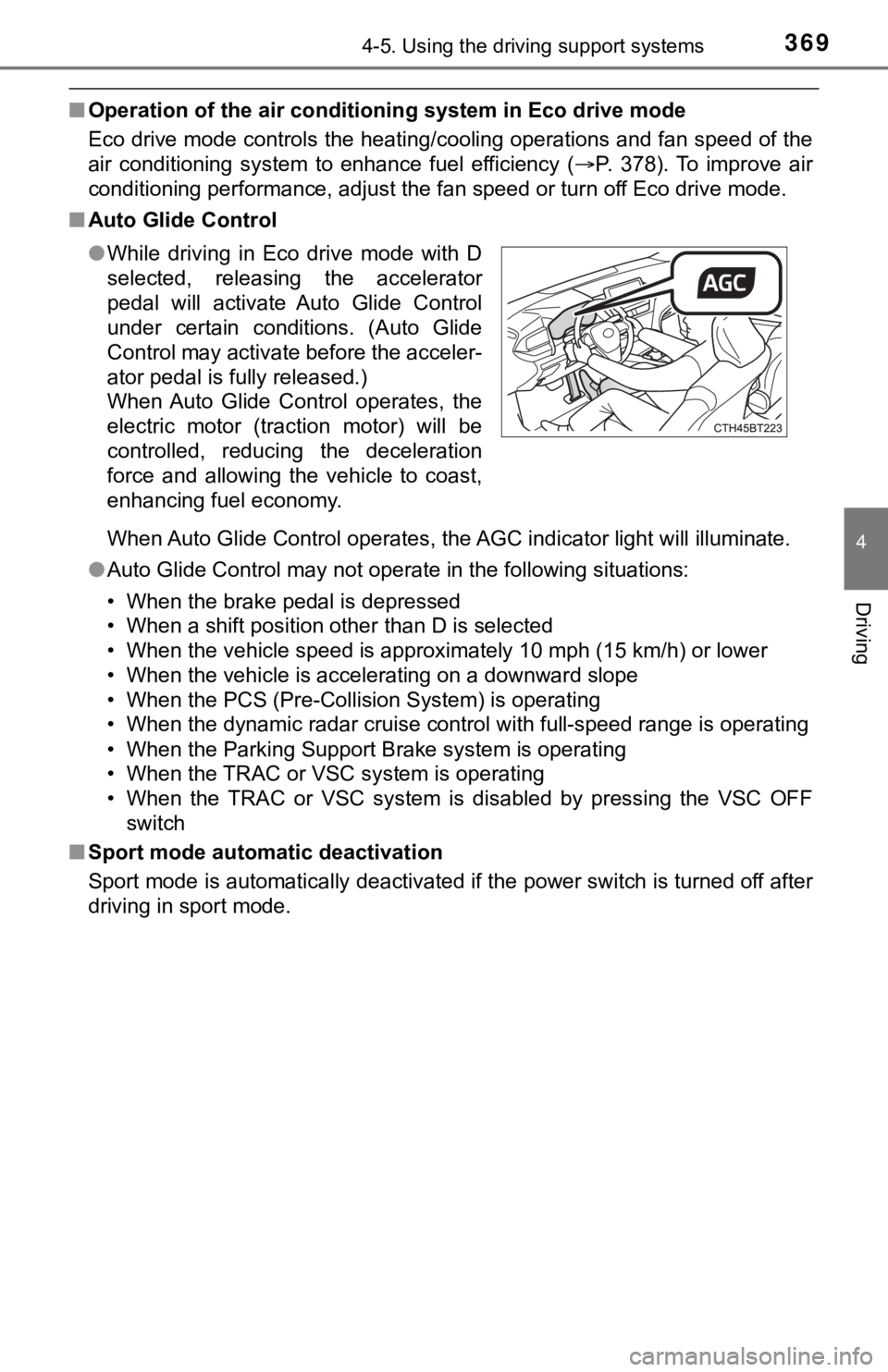
3694-5. Using the driving support systems
4
Driving
■Operation of the air conditioning system in Eco drive mode
Eco drive mode controls the heating/cooling operations and fan speed of the
air conditioning system to enhance fuel efficiency ( P. 378). To improve air
conditioning performance, adjust the fan speed or turn off Eco drive mode.
■ Auto Glide Control
When Auto Glide Control operates, the AGC indicator light will illuminate.
● Auto Glide Control may not operate in the following situations:
• When the brake pedal is depressed
• When a shift position other than D is selected
• When the vehicle speed is approximately 10 mph (15 km/h) or lo wer
• When the vehicle is accelerating on a downward slope
• When the PCS (Pre-Collision System) is operating
• When the dynamic radar cruise control with full-speed range is operating
• When the Parking Support Brake system is operating
• When the TRAC or VSC system is operating
• When the TRAC or VSC system is disabled by pressing the VSC OF F
switch
■ Sport mode automatic deactivation
Sport mode is automatically deactivated if the power switch is turned off after
driving in sport mode. ● While driving in Eco drive mode with D
selected, releasing the accelerator
pedal will activate Auto Glide Control
under certain conditions. (Auto Glide
Control may activate before the acceler-
ator pedal is fully released.)
When Auto Glide Control operates, the
electric motor (traction motor) will be
controlled, reducing the deceleration
force and allowing the vehicle to coast,
enhancing fuel economy.
Page 370 of 624

3704-6. Driving tips
◆Using Eco drive mode
When using Eco drive mode, the torque corresponding to the accel-
erator pedal depression amount can be generated more smoothly
than it is in normal conditions. In addition, the operation of the air
conditioning system (heating/coo ling) will be minimized, improving
the fuel economy. ( P. 368)
◆Use of Hybrid System Indicator
The Eco-friendly driving is possible by keeping the needle of H ybrid
System Indicator within Eco area. ( P. 104)
◆Shift lever operation
Shift the shift lever to D when stopped at a traffic light, or driving in
heavy traffic etc. Shift the shift lever to P when parking. When using
the N, there is no positive effe ct on fuel consumption. In the N, the
gasoline engine operates but e lectricity cannot be generated. A lso,
when using the air conditioning s ystem, etc., the hybrid battery
(traction battery) power is consumed.
◆Accelerator pedal/brake pedal operation
● Drive your vehicle smoothly. Avoid abrupt acceleration and
deceleration. Gradual accelerat ion and deceleration will make
more effective use of the electric motor (traction motor) witho ut
having to use gaso line engine power.
● Avoid repeated acceleration. Repeated acceleration consumes
hybrid battery (tracti on battery) power, resulting in poor fuel con-
sumption. Battery power can be restored by driving with the
accelerator pedal slightly released.
Hybrid vehicle driving tips
For economical and ecological dri ving, pay attention to the fol-
lowing points: